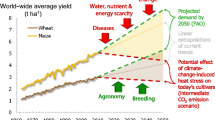Abstract
Farmers in Sahelian countries are confronted with a variety of soil fertility and management problems. During the last two decades, NGOs have worked with farmers and research institutions to develop and test practices that will increase food production, while at the same time enhance the natural resource base.
Since 1987, The Rodale Institute (RI) has worked closely with farmers' associations and government institutions to promote regenerative agriculture-farming systems that prioritize the use of local resources while improving them as they are used to grow food, using agro-ecological methods. The Senegalese Agricultural Research Institute has collaborated in this program as a partner of RI. The Senegal Regenerative Agriculture Resource Center model has been applied as a new and viable approach that builds on traditional knowledge and farmer-to-farmer exchange.
Research results on soil conservation and improvement have shown that fields spread with amended animal manure or compost yield greater harvests than fields farmed with traditional methods.
Similar content being viewed by others
References
Bationo, A., Mughogho, S.K. and Mokwunye, A.U.: 1986, ‘Abronomic evaluation of phosphate fertilizers in Tropical Africa’, in A.U. Mokwunye and P.L.G. Vlek (eds.), Management of Nitrogen and Phosphorus Fertilizers in Sub-Sahara Africa. Dordrecht, Netherlands, Martinus Nijhoff Publ.
Charreau, C.: 1974, ‘Soils of tropical dry and dry-wet climatic areas of West Africa, and their use and management’, Agronomy Mimeo 74-26. Ithaca, NY, Cornell University.
Dancette, C. and Sarr, P.: 1985, ‘Dégradation et regeneration des sols dans les régions Centre-Nord du Sénégal’, Senegal, ISRA, Dakar.
Freeman, P.: 1982, ‘Land regeneration and agricultural intensification in Senegal's groundnut basin’, USAID/Dakar.
Grosenick, G., Djegal, A., King, J., Karsh, E. and Warshall, P.: 1990, Senegal Natural Resources Management Assessment. Report for USAID/Senegal. PDC-5517-1-13-7136-00.
Koenig, R.: 1990, Cowpea and Millet Inter-cropping in Senegal: 1989 On-farm Research Results. Thesis work, The Rodale Institute/USAID Contract #685-0294.
The Rodale Institute: 1989, Soil Degradation and Prospects for Sustainable Agriculture in the Peanut Basin of Senegal, Report submitted to USAID/Dakar. August 15, 1989.
Sagna-Cabral, M.: 1988, ‘Utilization et gestion de la matière organique d'origine animale dans un terroir du centre nord Sénégal: cas du village de Ndiamsil-Sessène’, Mémoire d'étude Dijon, France.
Scherr, S.Y.: 1999, ‘Soil degradation: A threat to developing country food security by 2020’, IFPRI 2020 brief 58, 1999.
Swaminathan, M.S.: 1987, ‘The promise of agroforestry for ecological and nutritional security’, in International Council for Research in Agroforestry, Nairobi, Kenya, pp. 245-241.
Westley, K.: 1997, ‘Women, men, and manure: assessment of gender and wealth interactions in a soil restoration project in northern Senegal’, Journal of the Tropical Resources Institute 9-11.
World Bank: 1995, Sustainable Agriculture — Combining Human and Ecological Needs with Economic Development.
Author information
Authors and Affiliations
Rights and permissions
About this article
Cite this article
Diop, A.M. Sustainable Agriculture: New Paradigms and Old Practices? Increased Production with Management of Organic Inputs in Senegal. Environment, Development and Sustainability 1, 285–296 (1999). https://doi.org/10.1023/A:1010026922142
Issue Date:
DOI: https://doi.org/10.1023/A:1010026922142




